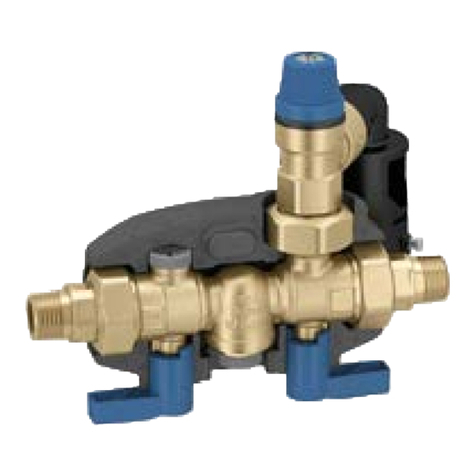
4
Installation
The SATK series H U is designed for installation in a sheltered
domestic environment (or similar), therefore cannot be installed or
used outdoors, i.e. in areas directly exposed to atmospheric
agents. Outdoor installation may cause malfunctioning and
hazards.
f the device is enclosed inside or between cabinets, sufficient
space must be provided for routine maintenance procedures. t is
advisable to avoid positioning electrical devices under the H U to
avoid the risk of damage in the event of leaks from hydraulic
fittings. f this advice is not heeded, the manufacturer cannot be
held responsible for any resulting damage.
n the event of a malfunction, fault or incorrect operation, the device
should be deactivated; contact a qualified technician for
assistance.
Preparation
After having established the point where the device has to be
installed, perform the following operations:
· Mark the holes required for securing the H U to the wall
· Mark the position of the hydraulic connections
Check the measurements again and begin laying the following
lines:
Hydraulic (see page 5):
1. connection to the central system line
2. heating circuit connection
3. domestic water circuit connection
Electric (see page 13):
1. 230 V (ac) – 50 Hz electric supply line
2. chrono-thermostat/thermostat line (potential-free)
3. centralised bus line for heat meter data transmission (if required)
4. centralised electric supply line for heat meter (if required)
Before installation, it is recommended to carry out accurate flushing
of all the pipes of the system in order to remove any residue or
impurities that could endanger correct operation of the H U.
Fix the H U to the wall.
N.B.: the wall anchors (not supplied) can only guarantee effective
support if inserted correctly (in accordance with good technical
practice) into walls built using solid or semi-solid bricks. If working
with walls built using perforated bricks or blocks, mobile dividing
panels or any masonry walls other than those indicated, a
preliminary static test must be carried out on the support system.
Electric connections
Make sure that the electrical system can withstand the maximum
power consumption of the appliance, with particular emphasis on
the cross-section of the cables.
f you have any doubts, contact a qualified technician to request a
thorough check of the electrical system.
Electrical safety of the appliance is only achieved when it is
correctly connected to an effective earthing system, made as
specified in current safety regulations. This is a compulsory safety
requirement.
Connection to the main supply
The device is supplied with an electric supply cable which is not
fitted with a plug.
The device should be electrically connected to a 230 V (ac) single-
phase + earth mains supply using the three-wire cable marked with
the label shown alongside, observing the L VE (L) - NEUTRAL (N)
polarities and the earth connection. This line must be connected to
a circuit breaker device.
Connection to the chrono-thermostat
The SATK series H U is fitted for connection to a thermostat or
chrono-thermostat, both standard and OpenTherm, for ambient
temperature adjustment.
The connection to this device (potential-free contact) must be
made with the two-wire cable marked with the label shown below.
Should it be necessary to extend this cable, use one with the same
cross-section (max 1 mm2) and maximum length 30 m.
Raumthermostat
(Potenzialfreier Kontakt)
Sonde d’ambiance
(Contact sec)
Termostato de ambiente
(Contacto sin potencial)
Ruimtesensor
(Schoon contact)
WARNING!
DO NOT CONNECT EXTERNAL
VOLTAGE SUPPLY TO THESE
TERMINALS
ATTENZIONE !
NON ALIMENTARE IN TENSIONE
Termostato ambiente
(Contatto pulito)
Room thermostat
(Volt free connection)
Fitting the cover
Place the casing over the frame, inserting the upper tabs (1) into
the corresponding slots (2).
Place the lower part of the casing over the frame.
Tighten the screws (3).
3
2
1
Commissioning
Filling the central heating system
Open the shut-off valves on the connections to the centralised line
and, in the central heating system, proceed with charging the
system to the design pressure.
Once these procedures are complete, vent the system and check
its pressure again (repeat the filling process if necessary)
System start-up
Before starting the H U, visually check the hydraulic connection
water-tightness and the electric wiring. After finishing the check,
activate the electric supply to the H U and check for the presence
of any error signals.
f there are any, eliminate the fault indicated and proceed as
described below, setting the set point of the domestic water and
heating cycles, programming the thermostat/chrono-thermostat
according to the desired temperatures and times, and checking the
operating cycles.




























